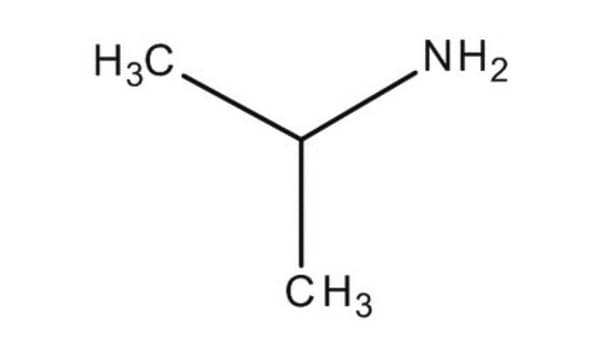45945
Isopropylamine
anhydrous, analytical standard
Sinónimos:
2-Aminopropane
About This Item
Productos recomendados
grado
analytical standard
densidad de vapor
2.04 (vs air)
presión de vapor
9.2 psi ( 20 °C)
temp. de autoignición
755 °F
calidad
anhydrous
caducidad
limited shelf life, expiry date on the label
lim. expl.
10.4 %
técnicas
HPLC: suitable
gas chromatography (GC): suitable
índice de refracción
n20/D 1.374 (lit.)
bp
33-34 °C (lit.)
densidad
0.688 g/mL at 20 °C (lit.)
aplicaciones
cleaning products
cosmetics
environmental
flavors and fragrances
food and beverages
personal care
formato
neat
temp. de almacenamiento
2-8°C
cadena SMILES
CC(C)N
InChI
1S/C3H9N/c1-3(2)4/h3H,4H2,1-2H3
Clave InChI
JJWLVOIRVHMVIS-UHFFFAOYSA-N
¿Está buscando productos similares? Visita Guía de comparación de productos
Aplicación
Productos recomendados
Palabra de señalización
Danger
Frases de peligro
Clasificaciones de peligro
Acute Tox. 3 Dermal - Acute Tox. 3 Inhalation - Acute Tox. 3 Oral - Flam. Liq. 1 - Skin Corr. 1A - STOT SE 3
Órganos de actuación
Respiratory system
Código de clase de almacenamiento
3 - Flammable liquids
Clase de riesgo para el agua (WGK)
WGK 1
Punto de inflamabilidad (°F)
<-13.0 °F - closed cup
Punto de inflamabilidad (°C)
<= -25 °C - closed cup
Equipo de protección personal
Faceshields, Gloves, Goggles
Elija entre una de las versiones más recientes:
¿Ya tiene este producto?
Encuentre la documentación para los productos que ha comprado recientemente en la Biblioteca de documentos.
Nuestro equipo de científicos tiene experiencia en todas las áreas de investigación: Ciencias de la vida, Ciencia de los materiales, Síntesis química, Cromatografía, Analítica y muchas otras.
Póngase en contacto con el Servicio técnico









